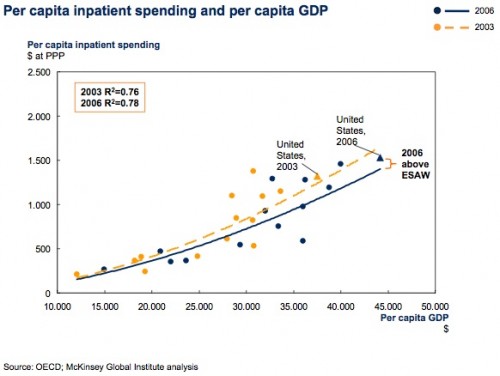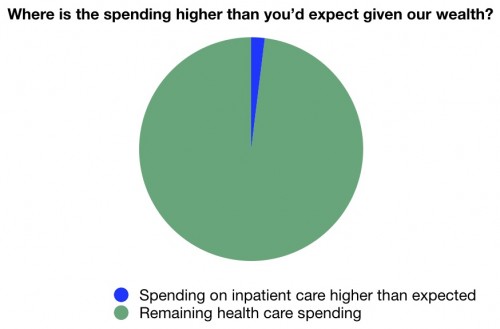If you haven’t read the introduction, go back and read it now. That introductory post also includes links to all the posts in this series on what makes our health care system so expensive. Each of these pieces is going to discuss one of the components of unexpected spending that accounts for why our system is so expensive.
Remember, these posts are going to follow a common theme. I am going to highlight how the United States is spending more than you’d expect given our wealth. Much of this comes from the McKinsey & Company study, Accounting for the cost of health care in the United States.
The first area of spending I’m going to discuss is inpatient care. In 2006, we spent $458 billion on hospital care, which – to be honest – might be less than you would have thought. Given our obsession with talking about end-of-life care and people demanding expensive surgeries, you would have thought this number might be higher. What might shock you is that even though it may feel like a low number, $40 billion of it is still more than you would have expected us to spend, given our wealth:
Now one of the reasons this number isn’t as high as you might expect is that the United States shifts more of its care to an outpatient setting than other countries (I’ll talk about that tomorrow). This does result in some cost savings for us. Additionally, we spend fewer days in the hospital than people in other countries (121 admissions per 1000 people per year US versus 179 OECD average). We also spend less days in the hospital for each admission, averaging 5.6 days versus 6.9 in other countries. But then we go and blow it by spending way, way more per hospital day ($2271 versus $920).
We also perform more than 25% more procedures than other countries, on average. In fact, the increased numbers of percutaneous coronary interventions, knee replacements, coronary bypasses, and cardiac catheterizations alone accounts for an extra $21 billion in additional inpatient costs. These procedures also increase the use of medical devices. And, since no one gets spared in this series, we have to acknowledge that medical devices cost more in the United States than in outer countries. In fact, we spend about $26 billion more than you would expect we would for such devices, given our wealth.
The way we organize our hospitals doesn’t help, either. Hospitals in the United States are smaller on average than those in other countries, and also are usually less filled than those in other countries. Because each hospital has significant fixed costs such as machinery, administration, and upkeep, this results in costs that are higher than you would expect for our wealth. This factor alone gives us $11 billion in extra costs.
I grant you that the absolute amount of our extra spending on inpatient costs shows it isn’t the biggest offender. But our organizational structure for inpatient care isn’t easily defensible. If you want to defend, so be it. I don’t think there’s a clear argument that involves better outcomes, but I hope I can be shown wrong. If not, if you’re serious about improving the cost curve, as well as outcomes, you have to include inpatient care in any discussion of system reform.
I will say this at the end of every one of these pieces. None of this proves that this money is wasted or fraudently taken. Nor am I saying that we shouldn’t spend more money than other countries. But this is money that goes above what you’d expect us to spend based on our greater wealth. We should at least be able to account for and explain this increased spending in some way.



